CBSE Class 12 Physics Chapter-3 Current Electricity Multiple Choice Questions And Answers
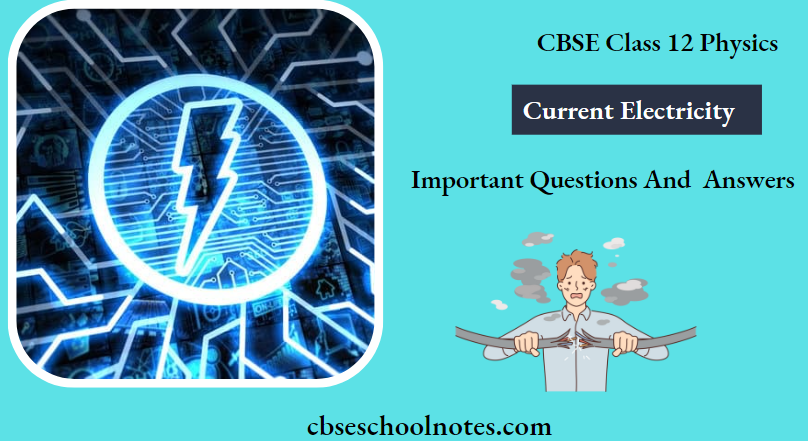
Question 1. In the circuit given below P≠R and the reading of the galvanometer is the same with switch S open or closed. Then:
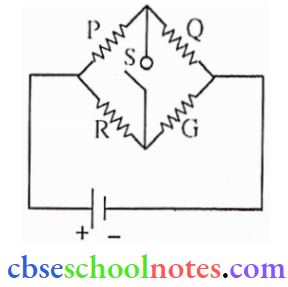
- IQ=IR
- IR=IG
- IP=IG
- IQ+IG
Answer: 4. IQ+IG
Read and Learn More Important Questions for Class 12 Physics with Answers
Question 2. Two wires A and B of the same material having length in the ratio 1:2 and diameter in the ratio 2:3 are connected in series with a battery. The ratio of the potential differences (VA/VB) across the two wires respectively is:
- 1/3
- 3/4
- 4/5
- 9/8
Answer: 4. 9/8
In Series, I → Same.
V = IR
⇒ \(\frac{V_A}{V_B}=\frac{R_A}{R_B}\)
⇒ \(R=\frac{\rho l}{A}=\frac{4 \rho l}{\pi d^2}\) [4, ρ, l, π – Constant]
∴ \(\frac{R_A}{R_B}=\frac{l_A}{l_B} \times\left(\frac{d B}{d A}\right)^2 = \frac{V_A}{V_{B}}=\frac{1}{2} \times\left(\frac{3}{2}\right)^2 = \frac{V_A}{V_{B}}=\frac{9}{8}\)
CBSE Class 12 Physics Chapter-3 Important Questions
Question 3. Infinity resistance in a resistance box has:
- A resistance of 105Ω
- A resistance of 107Ω
- A resistor of resistance
- A gap only
Answer: 4. A gap only
Question 4. A battery of 15V and negligible internal resistance is connected across a 50Ω resistor. The amount of energy dissipated as heal to the resistor in one minute is:
- 122 J
- 270 J
- 420 J
- 720 J
Answer: 2. 270 J
Use \(H=\frac{V^2}{R} t\)
Question 5. In a potentiometer experiment, the balancing length of a cell is 120cm. When the cell is shunted with a 1 Ω resistance, the balancing length becomes 40 cm. The internal resistance of the cell is:
- 10Ω
- 7Ω
- 3Ω
- 2Ω
Answer: 4. 2Ω
Question 6. Two students A and B calculate the charge flowing through a circuit. A concludes that 300 C of charge flows in 1 minute. B concludes that 3.125 x 1019 electrons flow in 1 second. If the current measured in the circuit is 5 A, then the correct calculation is done by:
- A
- B
- Both A and Both
- Neither A nor Both
Answer: 3. Both A and Both
⇒ \(I=\frac{q}{t}\) [for A]
∴ \(I=\frac{ne}{t}\) [for B]
Question 7. The resistances of two wires having the same length and the same area of cross-section arc 2Ω and 8 Ω respectively. If the resistivity of 2Ω wire is 2.65 x 10-8 m then the resistivity of 8Ω wire is:
- 10.60 x 10-4 Ω m
- 8.32 x 10-8 Ω m
- 7.61 x 10-8 Ωm
- 5.45 x 10-8 Ω m
Answer: 1. 10.60 x 10-4 Ω m
Use \(R=\frac{\rho l}{A}\)
⇒ \(\frac{\rho_2}{\rho_1}=\frac{R_2}{R_1}\)
⇒ \(\rho_2=\frac{8}{2} \times 2.65 \times 10^{-8}\)
∴ \(\rho_2=10.60 \times 10^{-8} \Omega \mathrm{m}\)
CBSE Class 12 Physics Chapter-3 Important Questions
Question 8. The given figure shows an I-V graph of a copper wire of length L and an area of cross-section A. The slope of the curve becomes
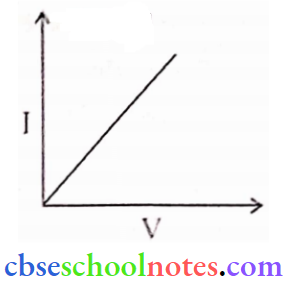
- Less if the length of the wire is increased
- More if the length of the wire is increased
- More if a wire of steel of the same dimension is used
- If the temperature of the wire is increased
Answer: 1. Less if the length of the wire is increased
⇒ \(\frac{I}{V}=\frac{1}{R}=\frac{A}{\rho l}\)
Slope = \(\frac{A}{\rho l}\)
l slope ↓
Question 9. When a potential difference V is applied across a conductor at temperature T. the drift velocity of the electrons is proportional to
- T
- √T
- V
- √V
Answer: 3. V
∴ \(v_d=\frac{c V}{m l} \bar{\tau}\)
∴ Vd ∝ V
Question 10. A cell supplies a current of 0.9 A through a 20 resistor and a current of 0.3 A through a 70 resistor. What is the internal resistance of cells?
- 0.5Ω
- 1.0Ω
- 1.2Ω
- 2.0Ω
Answer: 1. 0.5Ω
E = I1 (R1 + r) ⇒ E = 0.9(2 + r) →(1)
E = I2 (R2 + r) ⇒ E = 0.3 (7 + r) →(2)
From equation (1) and (2)
0.9 (2 + r) = 0.3 (7 + r)
6 + 3r = 7 + r
2r = 1 ⇒ r = 0.5 Ω
Question 11. At what temperature would the resistance of a copper conductor be double its resistance at 0°C? Given temperature coefficient of resistance for copper is 3.9 x 10-3 °C-1.
- 256.4°C
- 512.8°C
- 100°C
- 256.4 K
Answer: 1. 256.4°C
R1 = R0 (1 +∝ t)
2R0 = R0(1 + 3.9 x 10-3 x t) ⇒ \(\mathrm{t}=\frac{2-1}{0.0039}\) = 256.4°C
Question 12. A student is asked to connect four cells of emf e each and internal resistance r each in a series of helping conditions. By mistake, he oppositely connects one cell. What will be the effective EMF and effective internal resistance?
- 4ε, 2r
- 2ε, 4r
- 3ε, 2r
- 4ε, 4r
Answer: 2. 2ε, 4r
Question 13. In a hydrogen atom, the electron is moving in a circular orbit of radius 5.0 x 10-11 m with a constant speed of 2 x 106 m/s. The electric current formed due to the motion of electrons is _______.
- 1.12 A
- 1.02 A
- 1.02 mA
- 1.12 mA
Answer: 3. 1.02 mA
∴\(I=\frac{e V}{2 \pi r} ⇒ \) \(I=\frac{1.6 \times 10^{-19} \times 2 \times 10^6}{2 \times 3.14 \times 5 \times 10^{11}} \mathrm{~A}\) ⇒ I = 1.02 mA
CBSE Class 12 Physics Chapter-3 Important Questions
Question 14. A voltmeter of very high resistance is joined in the circuit as shown in the figure. The voltage shown by the voltmeter will be _________.
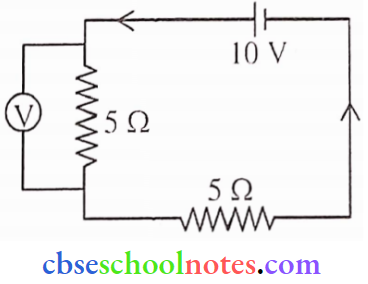
- 5 V
- 2.5 V
- 10 V
- 7.5 V
Answer: 1. 5 V
⇒ \(I=\frac{10}{5+5}=1 \mathrm{~A}\)
∴ V = IR = 1 x 5 = 5V
Question 15. The figure shows a part of a closed circuit. If the current flowing through it is 2A. What will be the potential difference between points B and A, VB– VA is:
image
- +2V
- +1 V
- -1V
- -2V
Answer: 4. -2V
Apply KVL
image
⇒ \(2 \times \frac{1}{4}+1+2 \times \frac{1}{4}=V_A-V_B\)
⇒ 2 = VA-VB
∴ VB-VA = -2V
Question 16. If the current in an electric bulb increases by 2%. what will be the change in the power of a bulb? (Assume that the resistance of the filament of a bulb remains constant).
- Decreases by 2%
- Decreases by 4%
- Increases by 2%
- Increases by 4%
Answer: 4. Increases by 4%
P = I2R
⇒ \(\frac{\Delta \mathrm{P}}{\mathrm{P}} \times 100=2 \frac{\Delta \mathrm{I}}{\mathrm{I}} \times 100\), R constant
⇒ 2 x 2
⇒ \(\frac{\Delta P}{P} \times 100=4\)
So power will increase by 4%.
Important Questions in Physics Class 12 – Current Electricity
Question 17. Two bulbs of 220 V and 100 W arc first connected in parallel and then in series with a supply of 220 V. Total power in both cases will be ______ respectively.
- 100 W. 50 W
- 50 W. 100 W
- 200 W. 50 W
- 50 W. 200 W
Answer: 3. 200 W. 50 W
In parallel → P = P1 + P2
P= 200 W
∴ Series \(\frac{1}{P}=\frac{1}{P_1}+\frac{1}{P_2}\)
So, P = 50 W
Question 18. Kirchhoff’s junction rule represents ________.
- Conservation of energy
- Conservation of linear momentum
- Conservation of angular momentum
- Conservation of charge
Answer: 4. Conservation of charge
Question 19. The device has powder P and voltage ‘V’. The connecting wires from the power station to the device have a finite resistance RC. The power dissipated in the connecting wires PC.
- \(\frac{V^2 R_C}{P}\)
- \(\frac{\mathrm{PR}_{\mathrm{C}}^2}{\mathrm{~V}}\)
- \(\frac{P^2 R_C}{V^2}\)
- \(\frac{V R_C}{P^2}\)
Answer: 3. \(\frac{P^2 R_C}{V^2}\)
Current following
∴ \(I=\frac{P}{V}\)
So power loss across the wire, Pe = I2RC
∴ \(P_e=\frac{P^2 R_e}{V^2}\)
Question 20. Dimension of mobility (μ) is _______.
- M-1T2A-1
- M1L3T-3A-2
- M1L3T-4A-1
- M1L4T-3A-1
Answer: 1. M-1T2A-1
Important Questions in Physics Class 12 – Current Electricity Assertion And Reason
For question numbers 1 to 4 two statements are given-one labelled Assertion (A) and the other labelled Reason (R). Select the correct answer to these questions from the codes (1). (2). (3) and (4) as given below.
- Both A and R are true and R is the correct explanation of A
- Both A and R are true but R is NOT the correct explanation of A
- A is true but R is false
- A is false and R is also false
Question 1. Assertion: The total current entering a circuit is equal to that leaving it by Kirchhoff’s law.
Reason: It is based on the conservation of charge.
Answer: 1. Both A and R are true and R is the correct explanation of A
Question 2. Assertion: The terminal potential of a cell is always less than its emf.
Reason: Potential drop due to internal resistance of cell increases the terminal potential difference.
Answer: 4. A is false and R is also false
Question 3. Assertion: The connecting wires are made of copper.
Reason: The electrical conductivity of copper is high.
Answer: 1. Both A and R are true and R is the correct explanation of A
Question 4. Assertion: There is no current in the metal in the absence of an electric field.
Reason: The motion of free electrons occurs randomly.
Answer: 1. Both A and R are true and R is the correct explanation of A
Class 12 Physics Current Electricity Short Answer Questions
Question 1. The variation of the drift velocity (vd) of electrons in two copper wires A and B of different lengths versus the potential difference (V) applied across their ends
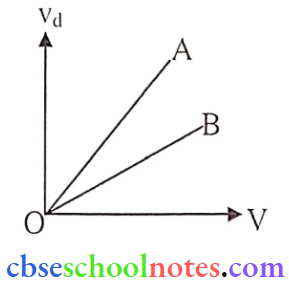
- What does the slope of the line represent?
- Which one of the two wires is longer?
Answer:
Vd = μE, V = El
⇒ \(\mathrm{v}_{\mathrm{d}}=\frac{\mu \mathrm{V}}{l}\)
⇒ \(v_{\mathrm{d}}=\left(\frac{\mu}{l}\right) \mathrm{V}\)
compare with y = mx
- Slope = \(\) = mobility of charge carriers
- For constant potential difference (Vd)A > (Vd)B
That’s why B has a longer wire.
Question 2. Two wires X and Y of the same material and equal lengths having areas of cross-section A and 2A respectively, are connected in parallel across an ideal battery of emf E. What is the ratio of current density (JX/JY) in them?
Answer:
⇒ \(J=\frac{I}{A}=\frac{E}{R A}\)
⇒ \(\mathrm{J}=\frac{\mathrm{E}}{\rho \ell} \times \frac{\mathrm{A}}{\mathrm{A}}\) (\(\mathrm{R}=\frac{\rho \mathrm{l}}{\mathrm{A}}\))
∴ \(J=\frac{E}{\rho l}\)
So, for both wires, E, ρ, and l are the same
∴ \(\frac{\mathrm{J}_x}{\mathrm{~J}_y}=1: 1\)
Question 3. When 5V potential difference is applied across a wire of length 0. 1 m. the drift speed of electrons is 2.5 x 10-4 m/s. If the electron density in the wire is 8 x 1028m-3 calculate the resistivity of the material of the wire.
Answer:
Given: V = 5V
Length of wire l = 0.1m
vd = 2.5 x 10-4 m/s
Electron density n = 8 x 1028 m-3
We know the drift velocity and current are related by the formula
i = ne A vd → (1)
Where n is the electron density, and e is the charge on an electron. A is an area of the cross-section and vd is drift velocity.
Also, i = V/R and R = ρl/A where p is resistivity. l is the length of the conductor
so, i = VA/ρl → (2)
comparing equation (1) and (2) we get.
VA / ρl = ne A Vd
or ρ = V / ne l vd
Put values of all.
ρ = 5/0.1 x 8 x 1028 x 1.6 x 10-19 x 2.5 x 10-4
ρ = 1.56 x l0-5 ohm-meter
Question 4. A battery of emf 12 V and internal resistance 2 Ω is connected to a 4 Ω resistor as shown in the figure.
- Show that a voltmeter when placed across the cell and the resistor, in turn, gives the same reading.
- To record the circuit’s voltage and current, why is the voltmeter placed in parallel and the ammeter in series in the circuit?

Answer:
1. When the voltmeter is connected across the cell
I = E/(R + r ) = 12 /(2 + 4) = 12/6 = 2 A
V1= E-Ir = 12- (2 x 2 ) = 8 V
When the voltmeter is connected across the resistor
V2 = ER /(r + R) = ( 12 x 4)/(4 + 2) = 12 x 4/6 = 8 V
So, v1 = v2
2. A Voltmeter is used to measure the potential difference across two points in a circuit since the voltage in the branches remains the same in a parallel connection. also the resistance of the voltmeter is very high due to which a very small current flows through the voltmeter so it is connected in parallel to measure the voltage.
An ammeter is used to measure the current flowing through a component/circuit. Since the current remains the same in series connections and also the resistance of an ammeter is very small it doesn’t affect the current to be measured. So an ammeter is connected in series to measure current.
Question 5. Two cells of EMFs 1.5 V and 2.0 V having internal resistance 0.2 Ω. and 0.3 Ω respectively are connected in parallel. Calculate the cnif and internal resistance of the equivalent cell.
Answer:

Given E1 = 1.5 V and r1 = 0.2 Ω
E2 = 2 V and r2 = 0.3 Ω
Equivalent emf = \(\frac{E_1 r_2+E_2 r_1}{r_1+r_2}=\frac{1.5 \times 0.3+2 \times 0.2}{0.5}=\frac{0.85}{0.5}=1.7 \mathrm{~V}\)
∴ Equivalent resistance = \(\frac{r_1 r_2}{r_1+r_2}=\frac{0.2 \times 0.3}{0.2+0.3}=\frac{0.06}{0.5}=0.12 \Omega\)
req, = 0.12 Ω
Question 6.
- Define the term ‘relaxation time’ in a conductor.
- Define the mobility of a charge carrier. What is its relation with relaxation lime?
Answer:
- Relaxation time is the average time interval between two successive collisions of an electron in a conductor when current flows.
- Mobility of a charge carrier is defined as the drift velocity of the charge carrier per unit electric field i.e μ = vd/E = eτ/m
Question 7. A metal rod of square cross-sectional area A having length ( has current 1 flowing through it and a potential difference of V volt is applied across its ends. Now the rod is cut parallel to its length into two identical pieces and joined as shown in Figure 2, What potential difference must be maintained across the length 2l so that the current in the rod is still 1?
Answer:

As, \(V=I R=\frac{I_\rho l}{A}\)
Now, \(\frac{V_{\text {new }}}{V}=\frac{l_{\text {new }}}{A_{\text {new }}} \times \frac{A}{l}=\frac{2}{1/2}\) OR Vnew = 4V
Now 4V potential difference must be maintained across the length 2l to maintain the same current in the rod.
Question 8. Two wires one of copper and the other of manganin have the same resistance and equal length. Which wire is thicker and why?
Answer:
Manganin is an alloy of Cu with manganese and nickel. Since manganese and nickel have a resistivity greater than copper, pure copper has lower resistivity as compared to alloy manganin. For the same resistance and equal length, manganin wire is thicker than copper.
∴ \(R=\rho \frac{l}{A} \Rightarrow \rho=\frac{R A}{l}\) (∵ \(\rho \propto A\))
Question 9. The plot of the variation of potential difference across a combination of three identical cells in series, versus current is shown below. What is the emf and internal resistance of each cell?
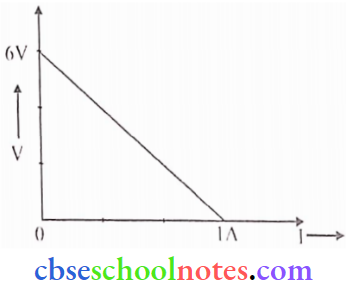
Answer:
V = Terminal voltage across cell combination
The terminal voltage across a cell can be obtained by subtracting the potential drop across the internal resistance of the cell from the emf of the cell.
V = E – IR
When I = 0, = V = E
From graph it is found that when I = 0, V = 6V ⇒ E = 6V
As I = 1A, V = 0 from graph
As V = E-Ir ⇒ 0 = 6-1.r => 6 = 1.r
r = 6 Ω
As 3 identical cells are connected in series so EMF and internal resistance of each cell are 2V and 2 Ω respectively.
Question 10.
- Derive an expression for the drift velocity of free electrons.
- How does the drift velocity of electrons in a metallic conductor vary with an increase in temperature? Explain.
Answer:
1. Drift velocity is defined as the average velocity with which free electrons in a conductor drift in a direction opposite to the direction of the applied electric field. When a conductor is subjected to an electric field E. each electron experiences a force.

⇒ \(\vec{F}=-\mathrm{e} \vec{E}\)
and acquires an acceleration
⇒ \(\mathrm{a}=\frac{\overrightarrow{\mathrm{F}}}{\mathrm{m}}=\frac{-\mathrm{e} \overrightarrow{\mathrm{E}}}{\mathrm{m}}\) → (1)
Here m = mass of the electron, e = charge. E = electric field. The average time difference between two consecutive collisions is known as the relaxation time of an electron.
⇒ \(\tau=\frac{\tau_1+\tau_2+\ldots \ldots+\tau_n}{n}\) → (2)
As v = u + at (from equations of motion)
The drift velocity vd is defined as
⇒ \(\vec{v}_{\mathrm{d}}=\frac{\vec{v}_1+\vec{v}_2+\ldots+\vec{v}_n}{n}\)
⇒ \(\overrightarrow{\mathrm{v}}_{\mathrm{d}}=\frac{\left(\overrightarrow{\mathrm{u}}_1+\overrightarrow{\mathrm{u}}_2+\ldots .+\overrightarrow{\mathrm{u}}_{\mathrm{n}}\right)+\mathrm{a}\left(\tau_1+\tau_2+\ldots .+\tau_{\mathrm{n}}\right)}{\mathrm{n}}\)
⇒ \(\vec{v}_d=0+\frac{a\left(\tau_1+\tau_2+\ldots .+\tau_n\right)}{n}\)
(∵ average thermal velocity = 0)
∴ \(\overrightarrow{\mathrm{v}}_{\mathrm{d}}=0+\mathrm{at}\)
⇒ \(\overrightarrow{\mathrm{v}}_{\mathrm{d}}=-\left(\frac{\mathrm{e} \overrightarrow{\mathrm{E}}}{\mathrm{m}}\right) \tau\) ⇒ (\(\left|\vec{v}_{\mathrm{d}}\right|=\left(\frac{e \tau}{m}\right) \vec{E}\))
2. According to the drift velocity expression, relaxation time is the time interval between successive collisions of an electron. On increasing temperature, the electrons move faster and more collisions occur more quickly. Hence, relaxation lime decreases with an increase in temperature which implies that drift velocity also decreases with temperature.
Question 11. Two identical cells of cmf 1.5 V each joined in parallel to supply energy to an external circuit consisting of two resistances of 7 Ω each joined in parallel. A very high resistance voltmeter reads the terminal voltage of cells to be 1.4 V. Calculate the internal resistance of each cell.
Answer:
A high resistance voltmeter means that no current flows through the voltmeter (practically very little current). When two batteries are connected in parallel, then
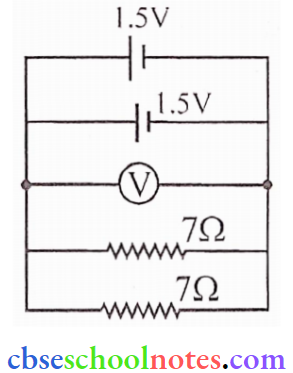
⇒ \(E_{eq}=\frac{E_1 r_2+E_2 r_1}{r_1+r_2}\)
Here r1 = r2 = r
E1 = E2 = I.5V (given)
⇒ \(\mathrm{E}_{\mathrm{eq}}=\frac{1.5 \times \mathrm{r}+1.5 \times \mathrm{r}}{2 \mathrm{r}}\)
Eeq = 1.5 V
Now \(\left.\begin{array}{l}
\mathrm{R}_1=7 \Omega \mathrm{R}_2=7 \Omega
\end{array}\right] \text { given }\)
So \(\frac{1}{R_{\mathrm{eq}}}=\left(\frac{1}{7}+\frac{1}{7}\right) \Omega\)
⇒ \(\mathrm{R}_{\mathrm{eq}}=\frac{7}{2}=3.5 \Omega\)
∵ \(I=\frac{\text { terminal voltage }}{\text { equivalent resistance }}\)
V = terminal voltage = 1.4 (given) = voltmeter reading
So, \(I=\frac{1.4}{3.5}=0.4 \mathrm{~A}\)
Now V = Eeq– 1 x req ⇒ 1.4= 1.5- 0.4 x req
0.4 x req = 0.1
As req = r/2 (∵ \(\frac{1}{r_{e q}}=\frac{1}{r}+\frac{1}{r}\))
So r of each cell = 0.5Ω
Question 12.
- Define the term ‘conductivity’ of a metallic wire. Write it’s ST unit.
- Using the concept of free electrons in a conductor, derive the expression for the conductivity of a wire in terms of number density and relaxation lime. Hence obtain the relation between current density and the applied electric field \(\vec{E}\).
Answer:
1. The conductivity of a material equals the reciprocal of the resistance of its wire of unit length and unit area of cross-section.
Alternatively:
The conductivity (σ) of a material is the reciprocal of its resistivity (ρ)
(Also acept \(\sigma=\frac{1}{\rho}\))
Its SI Units (\(\frac{1}{\text { olnm-metrc }}\)) or hom-1m-1 or (mho m-1) or sciemen m-1.
2. The Acceleration, \(\vec{a}=-\frac{e}{m} \vec{E}\)
The average drift velocity, Vd, is given by \(\vec{v}_{\mathrm{d}}=-\frac{\mathrm{e} \vec{\mathrm{E}}}{\mathrm{m}} \tau\)
(τ = average time between collisions or average relaxation lime)
If n is the number of free electrons per unit volume, then-current I is given by
⇒ \(I=n e A\left|v_d\right|\)
⇒ \(I=n e A\left(\frac{e \tau}{m}\right) E = I=\left(\frac{n e^2 \tau}{m}\right) E A\) (\(v_{\mathrm{d}}=\left(\frac{\mathrm{e} \tau}{\mathrm{m}}\right) \mathrm{E}\))
But I = J A (J = current density)
We, therefore, get
⇒ \(\mathrm{J}=\frac{\mathrm{ne}^2}{\mathrm{~m}} \tau \mathrm{E}\), The term \(\frac{n e^2}{m} \tau\) is conductivity.
∴ \(\sigma=\frac{\mathrm{ne}^2 \tau}{\mathrm{m}}\) ⇒ J = σE
Question 13.
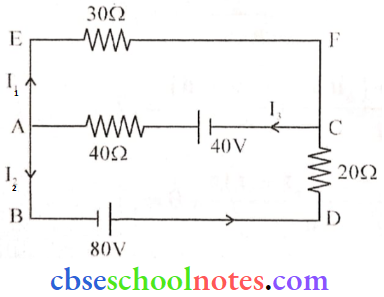
Use Kirchhoff’s rules, to calculate the current in the arm AC of the given circuit.
Answer:
Applying Kirchhoff’s junction rule at node A
I3 = I1+I2 → (1)
Applying Kirchhoff’s KVL in loop EFCAE
-30 I1+40-40 I3 = 0
3 I1+4 I3 = 4 → (2)
Applying KVL in loop EFDBE
-30 I1+20 I2 – 80 = 0
-3 I1 + 2 I2 = 8 → (3)
from eq (1) we put the value of I3 in eq (2)
3 I1 +4(I1 + I2) = 4
7 I1 +4 I2 = 4 → (4)
from eq (3) and (4) we get
I1 =-12/13 A
Putting I1 in eq (4) we get
⇒ \(\mathrm{I}_2=\frac{34}{13} \mathrm{~A}\)
Then form eq(1) we get \(\mathrm{I}_3=\frac{22}{13} \mathrm{~A}\)
Question 14.
- The potential difference applied across a given resistor is altered so that the heat produced per second increases by a factor of 9. By what factor does the applied potential difference change?
- In the figure shown, an ammeter A and a resistor of 4 Ω are connected to the terminals of the source. The emf of the source is 12 V having an internal resistance of 2 Ω. Calculate the voltmeter and ammeter readings.
Answer:
1. \(\mathrm{H}=\frac{\mathrm{V}^2}{\mathrm{R}} \mathrm{t}\) (initially) →(1)
After altering potential differences, we can write,
⇒ \(H^{\prime}=\frac{V^{\prime 2}}{R} t\)
∵ H’ = 9H we get,
⇒ \(9 \mathrm{H}=\frac{\mathrm{V}^{\prime 2}}{\mathrm{R}} \mathrm{t}\) → (2)
Solving (1) and (2) we get, V’ = 3V
2. 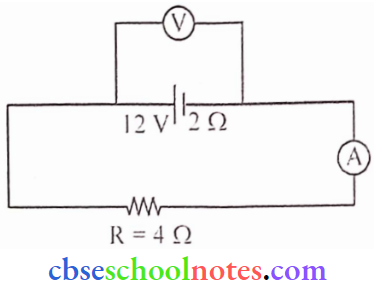
Total current ‘I’ in the circuit, \(I=\frac{E}{R+r}=\frac{R}{4+2}=2 A\)
Now potential differences across batteries is
V + Ir = E
V + 2 x 2 = 12
∴ V = 8 Volt
Class 12 Physics Current Electricity Long Answer Questions
Question 1. Wheatstone bridge is an arrangement of four resistances P, Q, R, and S connected as shown in the figure. Their values are so adjusted that the galvanometer G shows no deflection. The bridge is then said to be balanced when this condition is achieved. In the setup shown here, points B and D are at the same potential and it can be shown that P/Q = R/S This is called the balancing condition. If any three resistances are known, the fourth can be found. The practical form of the Wheatstone Bridge is a slide wire bridge or Meter Bridge. Using this the unknown resistance can be determined as \(S=\left(\frac{100-\ell}{\ell}\right) \times R\), where l is the balancing length of the meter bridge.
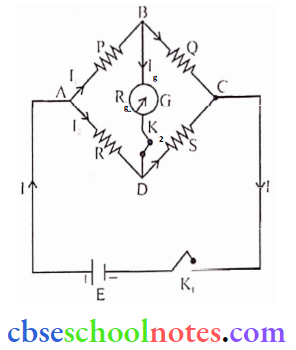
(1). In a Wheatstone bridge circuit, P = 5 Ohm, Q = 6 Ohm, R = 10 Ohm and S = 5 Ohm. What is the value of additional resistance to be used in series with S, so that the bridge is balanced?
- 9 Ohm
- 7 Ohm
- 10 Ohm
- 5 Ohm
Answer: 2. 7 Ohm
(2). A Wheatstone bridge consisting of four arms of resistance P, Q, R, S is most sensitive when
- All the resistance is equal
- All the resistance is unequal
- The resistance P and Q arc equal but R>>P and S>>Q
- The resistance P and Q are equal but R<<P and S<<Q
Answer: 1. All the resistance is equal
(3). The percentage error in measuring resistance with a meter bridge can be minimized by adjusting the balancing point close to
- 0
- 20 cm
- 50 cm
- 80 cm
Answer: 3. 50 cm
(4). In the meter bridge experiment, the ratio of the resistance of the left and light gap is 2 : 3. The balance point from the left is
- 20 cm
- 50 cm
- 40 cm
- 60 cm
Answer: 3. 40 cm
2. Relation between V, E, and r of a cell
Emf of a cell is the potential difference between two electrodes of the cell when no current is drawn from the cell. Internal resistance is the resistance offered by the electrolyte of a cell when the electric current flows through it. The internal resistance of a cell depends upon the following factors:
- Distance between the electrodes
- Nature and temperature of the electrolyte
- Nature of electrodes
- Area of electrodes.

For a freshly prepared cell, the value of internal resistance is generally low and goes on increasing as the cell is put to more use. The potential difference between the two electrodes of a cell in a closed circuit is called terminal potential difference and its value is less than the emf of the cell during discharging and more than the emf of the cell during charging of the cell in a closed circuit. It can be written as V = E – Ir or V = E + Ir
(1). The terminal potential difference of two electrodes of a cell is equal to cmf the cell when
- 1 ≠ 0
- 1 = 0
- Both (1) and (2)
- Neither (1) and (2)
Answer: 2. Both (1) and (2)
(2). A cell of cmf E and internal resistance r gives a current of 0.5 A with an external resistance of 12 Ohm and a current of 0.25 A with an external resistance of 25 Ohm. What is the value of the internal resistance of the cell?
- 5 Ohm
- 1 Ohm
- 7 Ohm
- 3 Ohm
Answer: 2. 1 Ohm
(3). If external resistance connected to a cell has been, increased to 5 times, the potential difference across the terminals of the cell increases from 10 V to 30 V. Then the cmf of the cell is
- 30 V
- 60 V
- 50 V
- 40 V
Answer: 60 V
(4). During the charging of the cell the correct relation is
- E = V + Ir
- E = V – Ir
- V = E + Ir
- V = E – Ir
Answer: 3. V = E + Ir
3. A battery is a combination of two or more cells. In the following figure, a single battery is represented in which two cells of emf ε1, and ε2, and internal resistance r1 and r2 respectively are connected.
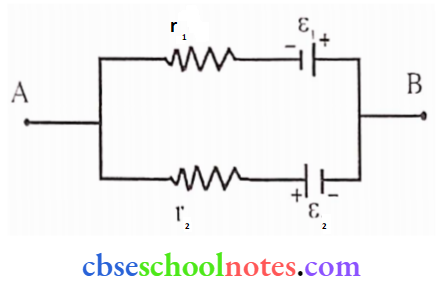
Answer the following Questions:
(1). The equivalent emf of this combination is:
- \(\frac{\varepsilon_1 r_1+\varepsilon_2 r_2}{r_1+r_2}\)
- \(\frac{\varepsilon_1 r_1-\varepsilon_2 r_2}{r_1+r_2}\)
- \(\frac{\varepsilon_1 r_2-\varepsilon_2 r_1}{r_1+r_2}\)
- \(\varepsilon_1-\varepsilon_2\)
Answer: 3. \(\frac{\varepsilon_1 r_2-\varepsilon_2 r_1}{r_1+r_2}\)
(2). For terminalB to be negative:
- \(\varepsilon_1 r_2>\varepsilon_2 r_1\)
- \(\varepsilon_1 r_2<\varepsilon_2 r_1\)
- \(\varepsilon_1 r_1>\varepsilon_2 r_2\)
- \(\varepsilon_2 r_2=\varepsilon_1 r_1\)
Answer: 2. \(\varepsilon_1 r_2<\varepsilon_2 r_1\)
(3). The current in the internal circuit is
- \(\frac{\varepsilon_1+\varepsilon_2}{r_1+r_2}\)
- \(\frac{\varepsilon_1-\varepsilon_2}{r_1+r_2}\)
- \(\frac{\varepsilon_1}{r_1}-\frac{\varepsilon_2}{r_2}\)
- \(\frac{\varepsilon_1}{r_2}-\frac{\varepsilon_2}{r_1}\)
Answer: 1. \(\frac{\varepsilon_1+\varepsilon_2}{r_1+r_2}\)
(4). The equivalent internal resistance of the combination is:
- \(\frac{r_1+r_2}{r_1 r_2}\)
- \(r_1+r_2\)
- \(\frac{r_1 r_2}{r_1+r_2}\)
- \(r_1-r_2\)
Answer: 3. \(\frac{r_1 r_2}{r_1+r_2}\)
Question 4.
- Define the term drift velocity.
- Based on electron drift, derive an expression for the resistivity of a conductor in terms of the number density of free electrons and relaxation lime. On what factors do the resistivity of a conductor depend?
- Why are alloys like Constantan and manganin arc used for making standard resistors?
Answer:
1. Drift velocity is defined as the average velocity with which the electrons drift towards the positive terminal under the effect of the applied electric field.
2. We know that the current flowing through the conductor is:

I = n A e vd
∴ \(\mathrm{l}=\mathrm{neA}\left(\frac{\mathrm{eE \tau}}{\mathrm{m}}\right)\)
Using \(E=\frac{V}{l}\)
⇒ \(I=n e A\left(\frac{e V}{m l}\right) \tau=\left(\frac{n e^2 A \tau}{m /}\right) V=\frac{1}{R} V\)
I ∝ V → which is Ohm’s law
Where \(R=\frac{m l}{n A e^2 \tau}\) is constant for a particular temperature and is called the resistance of the conductor.
∴ \(R=\left(\frac{m}{n e^2 \tau}\right) \frac{l}{A}=\frac{\rho l}{A} \Rightarrow \rho=\left(\frac{m}{n e^2 \tau}\right)\)
Where ρ is the specific resistance or resistivity of the material of the wire. It depends on the number of free electrons per unit volume and temperature
3. Alloys like constantan and manganin are used for making standard resistors, because:
- They have a high value of resistivity and
- The temperature coefficient of resistance is negligible
Question 5.
- Plot a graph showing the variation of voltage v/s the current drawn from the cell. How can one get information from this plot about the cmf of the cell and its internal resistance?
- Two cells of cmf’s E1, and E2, and internal resistance r1, and r2 arc connected in parallel. Obtain the expression for the emf and internal resistance of a single equivalent cell that can replace this combination.
Answer:
1. The terminal potential difference across the cell,
V = E – Ir or V = – rl + E

Comparing the above relation with the equation of a straight line i.e. y = mx + c, it follows that the graph between (along the x-axis) and V (along the y-axis) will be a straight line having a slope equal to -r and making intercept equal to E on the y-axis. Thus we get information about the EMF of the cell and its internal resistance from this plot.
2. 
I = I1 + I2 → (1)
v = VB1-VB2
V = Polcnlial difference across terminal B1 and B2
V = E1 – I1r1 – for first cell
V = E2 – I2r2 – for second cell
and I = I1 + I2 as per above eq(1)
So \(I=\frac{E_1-V}{r_1}+\frac{E_2-V}{r_2}=\left(\frac{E_1}{r_1}+\frac{E_2}{r_2}\right)-V\left(\frac{1}{r_1}+\frac{1}{r_2}\right)\) → (2)
\(I=\frac{E_{eq .}-V}{r_{eq .}}\) → (3)
By equation (2) and (3)
⇒ \(\frac{E_{eq .}-V}{r_{eq .}}=\left(\frac{E_1}{r_1}+\frac{E_2}{r_2}\right)-V\left(\frac{1}{r_1}+\frac{1}{r_2}\right)\)
Now, \(\frac{1}{r_{eq}}=\frac{1}{r_1}+\frac{1}{r_2}\) and \(\frac{E_{eq}}{r_{eq}}=\frac{E_1}{r_1}+\frac{E_2}{r_2}\)
∴ \(E_{eq}=\frac{E_1 r_2+E_2 r_1}{r_1+r_2}\) and \(r_{eq}=\frac{r_1 r_2}{r_1+r_2}\)
